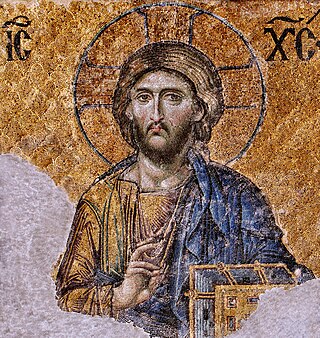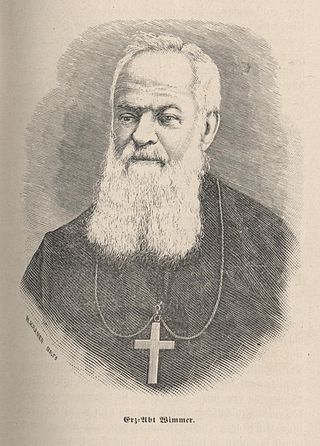
Benedict of Nursia, often known as Saint Benedict, was an Italian Christian monk, writer, and theologian who is venerated in the Catholic Church, the Eastern Orthodox Church, the Oriental Orthodox Churches, the Anglican Communion, and Old Catholic Churches. He is a patron saint of Europe.

The Benedictines, officially the Order of Saint Benedict, are a monastic religious order of the Catholic Church following the Rule of Saint Benedict. They are also sometimes called the Black Monks, in reference to the colour of their religious habits. They were founded by Benedict of Nursia, a 6th-century monk who laid the foundations of Benedictine monasticism through the formulation of his Rule of Saint Benedict.

The Rule of Saint Benedict is a book of precepts written in Latin in 516 by St Benedict of Nursia for monks living communally under the authority of an abbot.

Scholastica is a saint of the Catholic Church, the Eastern Orthodox Churches and the Anglican Communion. She was born in Italy, and a ninth-century tradition makes her the twin sister of Saint Benedict of Nursia. Her feast day is 10 February, Saint Scholastica's Day. Scholastica is traditionally regarded as the founder of the Benedictine nuns.

A monk is a person who practices religious asceticism by monastic living, either alone or with any number of other monks. A monk may be a person who decides to dedicate their life to serving other people and serving God, or to be an ascetic who voluntarily chooses to leave mainstream society and live their life in prayer and contemplation. The concept is ancient and can be seen in many religions and in philosophy.
In Christianity, an oblate is a person who is specifically dedicated to God and to God's service.

Basilian monks are Roman Catholic monks who follow the rule of Basil the Great, bishop of Caesarea (330–379). The term 'Basilian' is typically used only in the Catholic Church to distinguish Greek Catholic monks from other forms of monastic life in the Catholic Church. In the Eastern Orthodox Church, as all monks follow the Rule of Saint Basil, they do not distinguish themselves as 'Basilian'.

Maurus was the first disciple of Benedict of Nursia (512–584). He is mentioned in Gregory the Great's biography of the latter as the first oblate, offered to the monastery by his noble Roman parents as a young boy to be brought up in the monastic life.
The Cluniac Reforms were a series of changes within medieval monasticism of the Western Church focused on restoring the traditional monastic life, encouraging art, and caring for the poor. The movement began within the Benedictine order at Cluny Abbey, founded in 910 by William I, Duke of Aquitaine (875–918). The reforms were largely carried out by Saint Odo and spread throughout France, into England, and through much of Italy and Spain.

There are a number of Benedictine Anglican religious orders, some of them using the name Order of St. Benedict (OSB). Just like their Roman Catholic counterparts, each abbey/priory/convent is independent of each other. The vows are not made to an order, but to a local incarnation of the order, hence each individual order is free to develop its own character and charism, yet each under a common rule of life after the precepts of St. Benedict. Most of the communities include a confraternity of oblates. The order consists of a number of independent communities.

Solesmes Abbey or St. Peter's Abbey, Solesmes is a Benedictine monastery in Solesmes, Sarthe, France, famous as the source of the restoration of Benedictine monastic life in the country under Dom Prosper Guéranger after the French Revolution. The current abbot is the Right Reverend Dom Abbot Geoffrey Kemlin, O.S.B., elected in 2022.

The Saint Benedict Medal is a Christian sacramental medal containing symbols and text related to the life of Saint Benedict of Nursia, used by Roman Catholics, Lutherans, Western Orthodox, Anglicans and Methodists, in the Benedictine Christian tradition, especially votarists and oblates.
The Oblates of St. Frances of Rome are a monastic community in Rome of women oblates founded by St. Frances of Rome in 1433 to provide for a life of prayer and service among the wealthier women of the city. The group quickly developed a life in common, without monastic vows, committed to prayer and service to the poor of the city. They still continue today in this way of life here at their one and only monastery.

The Abbey of Saint Mary and Saint Louis is an abbey of the Catholic English Benedictine Congregation (EBC) located in Creve Coeur, in St. Louis County, Missouri in the United States. The Abbey is an important presence in the spiritual life of the Archdiocese of St. Louis. The monks of the Abbey live their faith according to the Benedictine discipline of 'prayer and work', praying the Divine Office five times daily, celebrating daily Masses in English and Latin, and working in the two parishes under their pastoral care and in the Saint Louis Priory School, which the Abbey runs as an apostolate. The Abbey and its school sit on a 150-acre (0.61 km2) campus in west St. Louis County, in the city of Creve Coeur.

A typikon is a liturgical book which contains instructions about the order of the Byzantine Rite office and variable hymns of the Divine Liturgy.

Western Rite Orthodoxy, also called Western Orthodoxy or the Orthodox Western Rite, are congregations within the Eastern Orthodox tradition which perform their liturgy in Western forms.
Christ the Saviour Monastery, also known as Christminster, is a Benedictine monastery of the Russian Orthodox Church Outside Russia (ROCOR) in Hamilton, Canada. The monastery is an institution of Western Rite Orthodoxy.

The American-Cassinese Congregation is a Catholic association of Benedictine monasteries founded in 1855. The monasteries of the congregation follow the monastic way of life as outlined by St. Benedict of Nursia in his early 6th century Rule of Saint Benedict. The congregation is one of 19 congregations in the Benedictine Confederation and includes 25 monasteries: 19 autonomous abbeys and 6 dependent priories, located across 15 states and Puerto Rico, as well as Brazil, Canada, Colombia, Mexico, and Taiwan.
The Subiaco Cassinese Congregation is an international union of Benedictine houses within the Benedictine Confederation. It developed from the Subiaco Congregation, which was formed in 1867 through the initiative of Dom Pietro Casaretto, O.S.B., as a reform of the way of life of monasteries of the Cassinese Congregation, formed in 1408, toward a stricter contemplative observance, and received final approval in 1872 by Pope Pius IX. After discussions between the two congregations at the start of the 21st century, approval was given by Pope Benedict XVI in 2013 for the incorporation of the Cassinese Congregation into its offshoot, the Subiaco Congregation. The expanded congregation was given this new name.

St. Andrew Abbey-Cleveland is a Benedictine monastery in Cleveland, Ohio.













